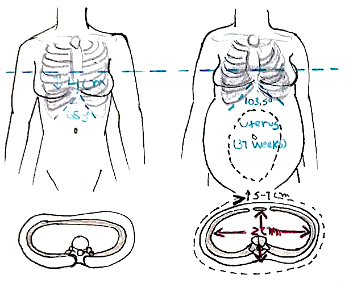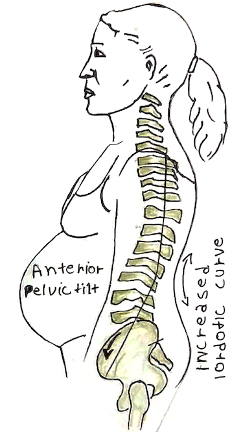To support the foetus, the mother must undergo several physiological changes to the different organ systems:
Cardiovascular:
There are several changes to the cardiovascular system, affecting a number of key variables:
i) Blood Volume:
– Blood volume increases in pregnancy due to activation of renin-angiotensin system
ii) Cardiac output:
– This increases in pregnancy due to increase in heart rate and stroke volume
– This is because heart undergoes eccentric hypertrophy during pregnancy
– This displaces the apex beat upwards and gives an innocent systolic murmur.
iii) Blood pressure:
– Despite the increase in cardiac output, systolic BP does not change
– Also, diastolic BP decreases in the 1st and 2nd trimester then returns to normal by term
– This is because progesterone acts to decrease systemic vascular resistance
N.B. The enlarged uterus may interfere with venous return. This can lead to ankle oedema, supine hypotension and varicose veins
Respiratory
In pregnancy, there is a need to increase oxygen in order to support the fetus. This is achieved by the hormone progesterone and also physical adaptations modifying the capacity of the thorax.
i) Progesterone:
– This hormone stimulates the respiratory centre
– It increases the respiratory rate and tidal volume
– Leads to a physiological, chronic compensated respiratory alkalosis
ii) Anatomical:
– The fetus causes upward displacement of the diaphragm
– There is compensatory increase in transverse diameter of the thorax
– This maintains total lung capacity

Endocrine
There are several hormonal changes which occur during pregnancy
i) Oestrogen + Progesterone:
Levels increase throughout pregnancy
ii) Thyroid:
– Total T3/T4 levels rise, whereas T3/T4 levels remain unchanged
– More oestrogen leads to hepatic production of Thyroxine Binding Globulin –> binds more T3
– This gives less free T3/T4 and so more TSH is released from the anterior pituitary
– This is important for fetus as thyroxin is needed for neural development and the foetal thyroid does not become functional until the second trimester
iii) Calcium:
– Requirements for calcium increase during pregnancy and lactation
– Gut absorption of calcium increases substantially (due to increased 1,25-dihydroxy vitamin D)
– It is advised in pregnancy to take a 10mg Vitamin D supplement daily
Metabolic:
There is an increase in human placental lactogen, prolactin and cortisol levels during pregnancy (mainly the second trimester), which are anti-insulin hormones.
– These hormones increase maternal insulin resistance, thus reducing uptake of glucose by maternal tissues
– This is needed to ensure that the fetus has a continuous supply of glucose but leads to an increased risk of the mother developing gestational diabetes.
Instead, the mother must switch to an alternative energy source:
– This is provided by free fatty acids (produced by lipolysis)
– But breakdown of lipids can result in ketogenesis
– Therefore, pregnancy is associated with an increased risk of ketoacidosis
Haematological
During pregnancy, there are several changes to the various components of blood and plasma:
i) Haematocrit:
– A physiological dilutional anaemia occurs during pregnancy, due to water reabsorption
– This means blood volume is increased more than red cell mass reducing haematocrit
ii) Cells:
– WBC count increases, RBC count increases but platelet concentration falls
iii) Clotting factors:
– Increased fibrinogen and clotting factors VII, VIII, X
– Decreased fibrinolysis with lower PT and APTT times
Renal
The renal system is affected by the increase in cardiac output, leading to greater filtration of the blood.
– GFR –> this increases due to higher blood flow, decreasing urea and creatinine levels
– There is relaxation of the ureters –> this leads to hydroureter with urinary frequency
– There is relaxation of the bladder –> this increases urinary stasis which predisposes to UTIs
GI
This has a mix of anatomical changes to accommodate the fetus and functional changes as a consequence:
i) Anatomical:
– The fetus causes increased compression of the stomach, increasing reflux
– There may also be displacement of the appendix to the RUQ
ii) Physiological changes:
– Smooth muscle relaxes due to increased progesterone
– This decreases gut motility increasing constipation
– It also leads to relaxation of the gallbladder increasing biliary stasis and gallstones
Hepatic
Hepatic blood flow does not change. The following changes in LFTs are observed:
– Elevated ALP –> as it is produced by placenta
– Decreased albumin –> due to the dilution of the blood
MSK
During pregnancy there is relaxation of the ligaments supporting the joints of the pelvic girdle
– This is to to help prepare for childbirth
– However the relaxing of the ligaments can cause lower back pain.
– Also increased lumbar lordosis helps to maintain the centre of gravity over the hip joints
– During pregnancy, there is an average weight gain of about 12.5kg (range = 7-23kg)


